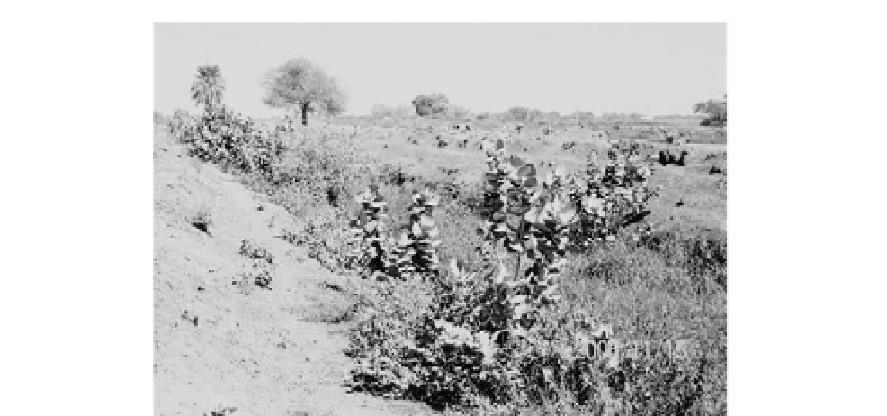Environmental Engineering Reference
In-Depth Information
Fig. 10.47
Soil moisture conditions determine the plant communities in riparian areas of the Nile River in Sudan
In altered or degraded stream systems, current moisture conditions in the riparian zone may be
dramatically unsuitable for the current, historical, or desired riparian vegetation. Several conditions can
be relatively easily identified by comparing the distribution of vegetation to the distribution of vegetation
suitabilities.
The hydrology of the stream has been altered, for example, if stream flow has diminished by diversion
or flood attenuation, sites in the riparian zone may be drier and no longer suitable for the historic
vegetation or for current long-lived vegetation that was established under a previous hydrologic regime.
The inundating discharges of plots in the riparian zone have been altered so that streamflow no longer
has the same relation to site moisture conditions; for example, levees, channel modifications, and bank
treatments may have either increased or decreased the discharge required to inundate plots in the riparian
zone. The vegetation of the riparian zone has been directly altered, for example, by clearing or planting
so that the vegetation on plots no longer corresponds to the natural vegetation for which the plots are
suitable.
Temporal variability is a particularly important characteristic of many stream ecosystems. Regular
seasonal differences in biological requirements are examples of temporal variability that are often
incorporated into biological analyses based on habitat suitability and time series simulations. The need
for episodic extreme events is easy to ignore because these are as widely perceived as destructive both to
biota and constructed river features. In reality, however, these extreme events seem to be essential to
physical channel maintenance and to the long-term suitability of the riverine ecosystem for disturbance-
dependent species.
Cottonwood in riparian systems in the western U.S. is one well understood case of a disturbance-
dependent species. Cottonwood regeneration from seed is generally restricted to bare, moist sites.
Creating these sites depends heavily on channel movement (meandering, narrowing, avulsion) or new
flood deposits at high elevations. In some riparian systems, channel movement and sediment deposition
on flood plains tend to occur infrequently in association with floods. The same events are also responsible
for destroying stands of trees. Thus, maintaining good conditions for existing stands, or fixing the
location of a stream's banks with structural measures, tends to reduce the regeneration potential and the
longterm importance of this disturbance-dependent species in the system as a whole.
There is a large body of information on the flooding tolerances of various plant species. Summaries of
this literature include Whitlow and Harris (1979) and the multivolume Impact of Water Level Changes
on Woody Riparian and Wetland Communities (Teskey and Hinckley, 1978; Walters et al., 1978; Lee and

Search WWH ::

Custom Search